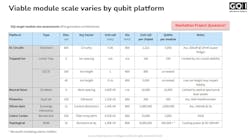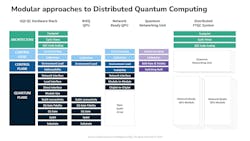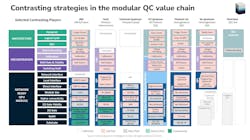Quantum networking: A critical bridge to utility-scale quantum computing
The quantum computing industry faces a fundamental scaling bottleneck that threatens to strand us in the era of noisy intermediate-scale quantum (NISQ) devices. While today’s leading systems boast hundreds of qubits, the transformative applications we seek—drug discovery, materials science, and cryptanalysis—demand fault-tolerant machines with millions of physical qubits. The harsh reality? No single quantum processing unit (QPU) can feasibly house that many qubits.
Consider the physical constraints across today’s quantum platforms. Superconducting circuits, limited by the cooling power of dilution refrigerators at 20 millikelvin (mK), cap out around 3,000 qubits per module (see Fig. 1). Trapped ion systems face stability limits in linear chains (100 qubits) or untested scaling in quantum charge-coupled device (QCCD) architectures. Even neutral atom arrays, despite their impressive 10,000-qubit potential, bump against optical aperture and laser power ceilings. Silicon spin qubits promise “millions” on paper, but thermal management at 1 K remains unproven.
The solution mirrors classical computing’s evolution: Modular, networked architectures (see Fig. 2). Just as data centers link thousands of processors, quantum computing must embrace distributed architectures where multiple quantum processing unit (QPU) modules collaborate through quantum networking. This isn’t merely about connecting boxes—it requires preserving the delicate quantum entanglement that gives these machines their power. This is where photonics emerges as a natural bridge and offers low-loss transmission of quantum states through optical fibers and the ability to generate entanglement between distant qubits via photon-mediated interactions.
From vision to venture capital: Modular won. Here's the proof.
Global Quantum Intelligence (GQI) identified this modular imperative more than three years ago and began advocating for distributed architectures while the industry still chased monolithic “Goliath” designs. Our May 2024 report “Scalable Quantum Hardware” mapped the technical requirements for quantum networking units (QNUs) that can bridge QPU modules while maintaining fault-tolerant operation.
The subsequent 12 months validated this vision spectacularly. The quantum networking sector has attracted significant funding and key developments emerged:
- Xanadu Aurora (January 2025): Achieved 12-qubit universal photonic quantum computer across 4 modular server racks interconnected via 13 kilometers of fiber, synthesizing an 86.4 billion mode cluster state.
- PsiQuantum Omega (February 2025): Unveiled chipset networking 35 photonic chips with 99.72% chip-to-chip quantum interconnect fidelity over distances up to 250 meters.
- Nu Quantum QNU (June 2025): Launched world’s first rack-mounted QNU with 99.7% entanglement fidelity and sub-microsecond circuit switching.
- Welinq (March 2025): Launched commercial quantum memory achieving world-record 90% storage-and-retrieval efficiency with 200-microsecond storage duration.
- Sparrow Quantum (April 2025): Secured €21.5M ($25.1M) Series A for deterministic single-photon sources, building on Danish quantum photonics leadership.
- Lightsynq (November 2024): Raised $18M for diamond-based optical quantum interconnects, subsequently acquired by IonQ in May 2025.
- SilQ Connect (May 2025): Launched from Sherbrooke, Canada with pre-seed funding for microwave-optical quantum interconnects enabling quantum local area networks.
- Cisco’s quantum chip (May 2025): Room-temperature operation generates 200 million entangled photon pairs per second.
Even traditionally monolithic players now embrace modularity. IBM’s 2025 roadmap features “l-type” meter-scale quantum links between dilution fridges. IonQ’s acquisition spree—Oxford Ionics, Lightsynq, ID Quantique—transforms it from a compute-only vendor into a full-stack quantum networking company. The Quantum Data Center Alliance, led by Nu Quantum, brings together Cisco, QphoX, Oxford Quantum Circuits, and others to standardize interfaces for building-scale quantum networks.
Photonic value chain: Who owns the quantum highway?
The race to build quantum networks has crystallized distinct strategies across the photonic value chain (see Fig. 3). Each approach reveals different bets on how light will enable million-qubit machines:
Homogeneous integration. Photonic Inc. pursues silicon T-centers (carbon-based color center) that natively combine spin qubits with optical interfaces within the same material platform. Their integrated waveguide cavities promise efficient qubit-photon interfaces without heterogeneous assembly.
Heterogeneous enablement. Nu Quantum develops high-performance photonic cavities compatible with multiple qubit platforms—trapped ions, neutral atoms, and color centers. Their QNU’s modular architecture allows optical modules to be swapped to support different qubit types, positioning them as the essential middleware provider.
All-photonic computing. PsiQuantum and Xanadu need no qubit-photon interface; photons serve as both qubits and interconnects. PsiQuantum’s Active Volume architecture and Xanadu’s squeezed-light approach use optical switching and delay lines to create data center-scale quantum computers from networked photonic chips.
Critical supporting technologies span the photonic spectrum:
- Single-photon sources (Sparrow Quantum, Qunnect): Deterministic generation for high-fidelity entanglement—Sparrow’s on-chip sources set industry benchmarks.
- Quantum memories (Welinq, MemQ): Store and synchronize entanglement—Welinq’s room-temperature operation eliminates cryogenic requirements.
- Transducers (QphoX, SilQ Connect): Convert between microwave and optical domains.
- Single-photon detectors (ID Quantique, Single Quantum, Quantum Opus): Enable high-efficiency Bell state measurements.
The ecosystem extends beyond these specialized components, with many other photonic players advancing the field—Aegiq, ORCA Computing, Quandela, QuiX Quantum, and Quantum Source—each contributing unique approaches to photonic quantum computing and networking.
The message is clear: Quantum networking isn’t a future consideration—it’s the present battlefield where quantum computing’s leaders will be determined. For the photonics community, this represents a generational opportunity to provide the critical infrastructure that transforms quantum computing from laboratory curiosity to world-changing technology. The path to a million qubits can run through optical fiber, and those who master quantum networking will define the next era of computation.
FURTHER READING
GQI Outlook Report; Scalable Quantum Hardware:
www.global-qi.com/product-page/outlook-report-scalable-quantum-hardware-24
About the Author
Michael Baczyk
Michael Baczyk is VP of business intelligence for Global Quantum Intelligence (GQI), a business intelligence firm for quantum technology (New York, NY and London, U.K.).



